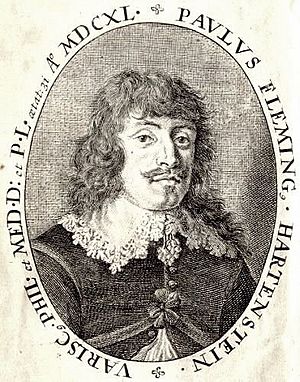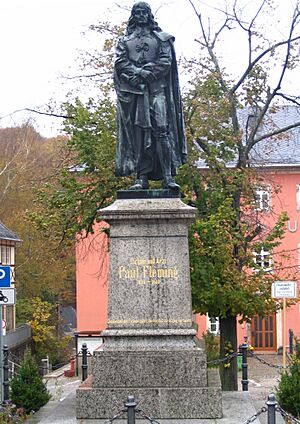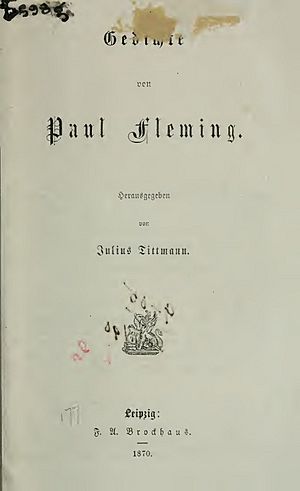Paul Fleming (poet) facts for kids
Quick facts for kids
Paul Fleming
|
|
|---|---|
 |
|
| Born | 5 October 1609 |
| Died | 2 April 1640 (aged 30) |
| Nationality | German |
| Other names | Paul Flemming |
| Education | St. Thomas School, Leipzig |
| Alma mater | Leipzig University |
| Occupation | |
Paul Fleming, also spelled Flemming (born October 5, 1609 – died April 2, 1640), was a very talented German doctor and poet. He wrote many famous poems and religious songs called hymns.
He spent several years traveling with important trips (called embassies) for the Duke of Holstein. These journeys took him to faraway places like Russia and Persia. He also lived for about a year in a city called Reval (now Tallinn) on the coast of Estonia. While there, he wrote many beautiful love songs.
Contents
Life and Travels of Paul Fleming
Paul Fleming was born in a town called Hartenstein, in a region of Saxony, Germany, known as Erzgebirge. His father, Abraham Fleming, was a well-known Lutheran pastor. Paul received his first lessons from his father.
He later attended a school in Mittweida. After that, he went to the famous St. Thomas School in Leipzig. He started his medical training at Leipzig University. There, he also studied literature and earned a degree in philosophy. He later completed his medical degree at the University of Hamburg.
Escaping the Thirty Years' War
The Thirty Years' War was a big conflict in Europe. It forced Fleming to move to a place called Holstein. In 1633, Frederick III, Duke of Holstein-Gottorp, hired him. Paul Fleming worked for the Duke as a doctor, a courtier (someone who attends a royal court), and a manager.
Journeys to Russia and Persia
Towards the end of 1633, the Duke sent Fleming on an important trip. He joined Adam Olearius as part of an embassy (a group of official representatives) to Russia and the Persian Empire. This journey was led by Otto Brüggemann and Philipp Kruse.
Fleming spent almost six years outside Germany. Much of this time was spent in Russia and Persia. As they traveled into Russia, Fleming was in an early group of the embassy. They went to Novgorod, where he stayed while talks happened with the Swedes and Russians.
In July 1634, the main ambassadors joined the group. The embassy then continued to Moscow, arriving in August. After four months in Moscow, the Holstein embassy left for the Baltic Sea in December 1634. They arrived in Reval (now Tallinn) in Swedish Estonia in January 1635.
Life in Reval and Return Home
While the main ambassadors went back to Gottorp, some of the group, including Fleming, stayed in Reval. Fleming lived there for about a year. During this time, he started a poetry group called "the Shepherds."
Soon after arriving in Reval, Fleming fell in love with Elsabe Niehus. She was the daughter of a merchant from Hamburg. He wrote many love poems for her, and they became engaged to be married.
In 1636, the embassy continued its journey to Persia, visiting Moscow again on the way. Elsabe stayed behind. Fleming wrote four letters in verse (poems) during his time in Persia, between 1636 and 1638. The embassy was in a city called Isfahan in 1637.
When Fleming returned to Reval, he found that Elsabe had married someone else. He then became engaged to her sister, Anna Niehus.
In 1639, Fleming went back to his medical studies at the University of Leiden. He earned his doctorate in 1640. He then settled in Hamburg, where he sadly passed away on April 2, 1640.
Paul Fleming's Poetry
Paul Fleming is considered one of the most important German poets of his time. He is often grouped with other writers like Martin Opitz and Andreas Gryphius. These poets are sometimes called "the Silesian poets." Fleming is known as one of the best German lyric poets. A lyric poet writes poems that express strong emotions.
Famous Poems and Collections
Some of Fleming's well-known poems include Auf den Tod eines Kindes (On the Death of a Child) and Madrigal. Many of his sonnets (a type of 14-line poem) are about the places he visited during his travels.
Only a few of his collections were published while he was alive:
- Rubella seu Suaviorum Liber (1631)
- Klagegedichte über das unschuldigste Leiden und Tod unsers Erlösers Jesu Christi (Laments concerning the most innocent Suffering and Death of our Saviour Jesus Christ), published in 1632. This second collection begins with a call to Melpomene, the Muse of tragedy.
His Teutsche Poemata (Poems in German) was published after he died in 1642. This collection was later renamed Geistliche und weltliche Gedichte (Spiritual and Secular Poems). It contains many of his famous love songs.
Fleming wrote poems in both Latin and German. His Latin poems were collected and published in one book in 1863. Many people have praised Fleming's writing. He has been called a man of "real poetic genius" and "possibly the greatest German lyric poet of the seventeenth century." The famous writer Günter Grass called him "one of the major figures in German seventeenth-century literature."
Musical Settings of Fleming's Works
Paul Fleming wrote a hymn (a religious song) with nine stanzas called "In allen meinen Taten" (In all that I do). He used the tune of "Innsbruck, ich muss dich lassen" by Heinrich Isaac. This hymn is still found in many hymnals today.
The famous composer Johann Sebastian Bach used the last stanza of this hymn in two of his cantatas: Meine Seufzer, meine Tränen (BWV 13) and Sie werden euch in den Bann tun (BWV 44). Bach also created a full chorale cantata based on the complete hymn, called In allen meinen Taten (BWV 97).
Even in the 17th century, another composer named David Pohle (1624–1695) set twelve of Fleming's love songs to music. Later, Johannes Brahms set "Lass dich nur nichts bedauern" as Geistliches Lied, Op. 30. Pauline Volkstein also used Fleming’s texts for her music.
Works by Paul Fleming
- Rubella seu Suaviorum Liber (1631)
- Klagegedichte über das unschüldigste Leiden undt Tod unsers Erlösers Jesu Christi (Laments concerning the most innocent Suffering and Death of our Saviour Jesus Christ) (1632)
- Prodromus (1641)
- Teutsche Poemata (Poems in German) (1646)
- Geistliche und weltliche Gedichte (Spiritual and Secular Poems) was the title of later editions of Teutsche Poemata
See also
 In Spanish: Paul Fleming para niños
In Spanish: Paul Fleming para niños



